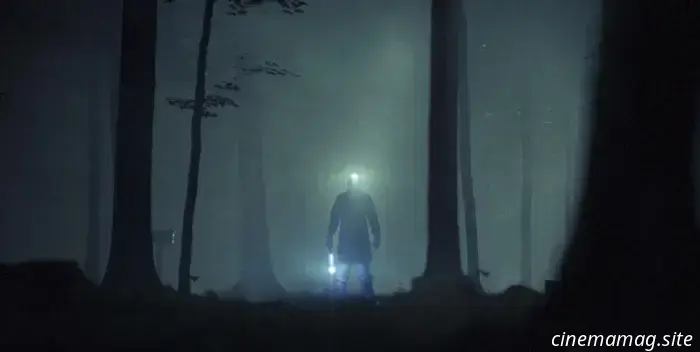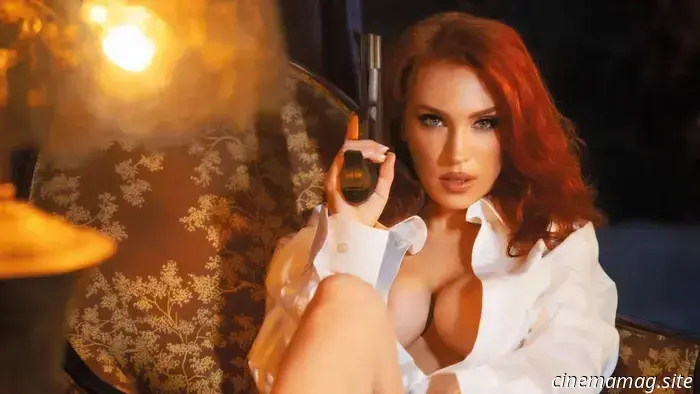
The Monkey Review: Osgood Perkins Makes a Comeback with a Clever, Humorous Killing Rampage
In one of the many cleverly executed references to Once Upon a Time in Hollywood, Cinerama-style red and blue credits emerge over a black screen, accompanied by sizzling ’60s surf rock, creating a sense of violent joy. Suddenly, the scene bursts open inside a sickly green pawn shop, where the circus ringmaster Adam Scott stands, visibly anxious, with a toy monkey nearby. It doesn’t take long before he’s unleashing a flamethrower and furiously shouting, “You infernal son of a whore!” with intense anger, his stance firm and one shoulder pulled back reminiscent of Rick Dalton roasting Nazis in The 14 Fists of McCluskey. It sets the stage perfectly for the comedic carnage that follows.
There's no beating around the bush: The Monkey serves as a medium for capturing visually impressive kills. However, it’s not just about stylish killings––these are extravagant kills, backed by an eight-figure budget, conceived by Stephen King, developed by an unconventional creative team, and directed by a maturing Osgood Perkins, who seems to enjoy a significant degree of artistic freedom with his semi-independent studio supporters. When was the last time you encountered a well-funded, thoughtfully crafted, straightforward “1,000 Ways to Die” horror comedy?
The plot is quite thin: twin boys and their mother left behind by their father, who also deserted a large cylindrical box. Growing up without a dad, the children rely on their mother (Tatiana Maslany) for everything. She ranges from the ideal 1950s floral-dress mother to a dark Marla Singer figure, doling out unsettling existential truths like “everyone dies,” but lacking the comfort typically associated with a parent's reassurances about the joys of life before death. Despite the absence of their father, his presence looms large.
The Monkey purports to explore the theme of “fathers passing horrors onto their children,” as indicated by Theo James’ voiceover. It’s a superficial examination of the theme at best, yet it aligns with Perkins’ perspective. With a line like that early on, one can’t help but reflect on the Hollywood lineage of the actor-turned-director and the curses inherited from his parent, many of which have been extensively discussed.
Oz Perkins is the son of Anthony Perkins, the iconic Psycho actor who entered into a marriage to uphold his public image, stayed in the closet his entire life for fear of being ostracized from Hollywood and his acting career, while raising a son under the weight of it all. That must have come with its own distinct set of challenges, even if they aren’t directly addressed or infused into the film.
When the boys finally decide to open their father’s toy box, a heavy atmosphere akin to Jumanji (which also deals with fathers passing down horrors to their children, featuring Jonathan Hyde as both a stern parent and a menacing hunter) settles in, with dread building beneath the lid. Upon removing it, they discover a toy monkey with hollow, glassy eyes, creepy ivory teeth, a frozen grin, and an expression of constant alertness––a genuinely frightening toy in the right lighting, context, and score. On the back of the lid is a bright red sticker that reads “Turn the key and see what happens.” They do, and people die. They grapple with complex emotions about this. They attempt to dispose of it but only temporarily succeed, as it eventually returns, and nothing conclusive transpires.
Unsurprisingly, it comes back. There’s no logic to who it chooses to kill. The monkey kills without rhyme or reason––perhaps even out of spite at times––but never intentionally. By the time the boys grow up and Theo James is caricaturing them both––one essentially a Velma character and the other a mulleted Sid from Toy Story, which bizarrely works for the former but not for the latter––all interest in plot or theme dissipates; the focus shifts to the next inventive kill. To Perkins’ credit, he delivers.
The lack of a solid plot is offset by the suspense generated by the ever-looming deaths caused by the magical, all-knowing killer toy monkey. What intricate, Rube Goldberg-like sequence of events is about to unfold? It resembles Final Destination, but the gritty early-2000s shadowy vibe and desperate narrative appeal are replaced with a cinematic ’60s glow and an awareness that the enjoyment lies in the comic madness of the kills, enhanced by clever filmmaking and succinct execution.
It’s straightforward. You turn the key on its back, and it all unfolds: the monkey slowly reveals its enormous teeth, then its meaty gums; it raises its stiff hand, twirls its drumstick in its palm, locks it into position, and begins to bang furiously on its little snare drum to an exhilarating carnie-horror tune emanating from it. Once it finishes, chaos ensues. And boy, does it.
Other articles
 NYC Weekend Spotlight: Hideaki Anno, Claude Chabrol, Pale Flower, and More
NYC Weekend Watch is our weekly summary of repertory selections. IFC Center features a new restoration of Hideaki Anno's Love & Pop; also screening are Herzog's Nosferatu, Mulholland Dr., Funeral Parade of Roses, The Thing, and Irreversible late at night. At Roxy Cinema, Saturday will include Bruce LaBruce presenting Ciao! Manhattan and Melody of Love on 16mm. This Sunday, Claude Chabrol's Ten Days Wonder will be shown on 16mm as well.
NYC Weekend Spotlight: Hideaki Anno, Claude Chabrol, Pale Flower, and More
NYC Weekend Watch is our weekly summary of repertory selections. IFC Center features a new restoration of Hideaki Anno's Love & Pop; also screening are Herzog's Nosferatu, Mulholland Dr., Funeral Parade of Roses, The Thing, and Irreversible late at night. At Roxy Cinema, Saturday will include Bruce LaBruce presenting Ciao! Manhattan and Melody of Love on 16mm. This Sunday, Claude Chabrol's Ten Days Wonder will be shown on 16mm as well.
 The horror film "Summer Camp" featuring Marshmallow has unveiled a trailer and a poster.
A poster and trailer have been released online for Marshmallow, the forthcoming horror film directed by Daniel DelPurgatorio. The story follows 12-year-old Morgan and his new pals as they become trapped in a waking nightmare when a campfire story comes to life, instilling fear in the young campers at the isolated summer camp. The cast features […]
The horror film "Summer Camp" featuring Marshmallow has unveiled a trailer and a poster.
A poster and trailer have been released online for Marshmallow, the forthcoming horror film directed by Daniel DelPurgatorio. The story follows 12-year-old Morgan and his new pals as they become trapped in a waking nightmare when a campfire story comes to life, instilling fear in the young campers at the isolated summer camp. The cast features […]
 PCS Collectibles has unveiled the Fine Art Bust of Darth Vader from Star Wars.
Sideshow and PCS have unveiled the Darth Vader Fine Art Bust, showcasing the legendary Sith Lord amidst significant moments from Anakin Skywalker's saga. This Star Wars collectible is currently available for pre-order at a price of $2,204; check it out here… Sideshow and Premium Collectibles Studio are excited to introduce the Darth […]
PCS Collectibles has unveiled the Fine Art Bust of Darth Vader from Star Wars.
Sideshow and PCS have unveiled the Darth Vader Fine Art Bust, showcasing the legendary Sith Lord amidst significant moments from Anakin Skywalker's saga. This Star Wars collectible is currently available for pre-order at a price of $2,204; check it out here… Sideshow and Premium Collectibles Studio are excited to introduce the Darth […]
 The trailer for the indie slasher Butchers Bluff reveals the Hogman.
Breaking Glass Pictures has released a trailer and poster for Butchers Bluff, an homage to 80s slasher films directed by William Instone and Matt Rifley. The story revolves around a group of students who quickly come to regret their decision to investigate the legend of the Hogman in a small Texas town, especially after 28 people have gone missing over two...
The trailer for the indie slasher Butchers Bluff reveals the Hogman.
Breaking Glass Pictures has released a trailer and poster for Butchers Bluff, an homage to 80s slasher films directed by William Instone and Matt Rifley. The story revolves around a group of students who quickly come to regret their decision to investigate the legend of the Hogman in a small Texas town, especially after 28 people have gone missing over two...
 Heat Seeker: Exposed - A Gun Honey Series has been announced by Titan and Hard Case Crime.
Titan Comics and Hard Case Crime have revealed that their popular Gun Honey spinoff, Heat Seeker, will make a comeback in May with a brand-new four-issue series titled Heat Seeker: Exposed – A Gun Honey Series, written by Charles Ardai and illustrated by Ace Continuado. As an unyielding investigative reporter aims to unveil her illicit actions, the mistress [...]
Heat Seeker: Exposed - A Gun Honey Series has been announced by Titan and Hard Case Crime.
Titan Comics and Hard Case Crime have revealed that their popular Gun Honey spinoff, Heat Seeker, will make a comeback in May with a brand-new four-issue series titled Heat Seeker: Exposed – A Gun Honey Series, written by Charles Ardai and illustrated by Ace Continuado. As an unyielding investigative reporter aims to unveil her illicit actions, the mistress [...]
The Monkey Review: Osgood Perkins Makes a Comeback with a Clever, Humorous Killing Rampage
In a well-crafted reference to Once Upon a Time in Hollywood, Cinerama-inspired red and blue credits roll across a black screen, accompanied by energetic '60s surf rock, creating an atmosphere of excited chaos. Abruptly, we burst into a grimy green pawn shop where circus ringmaster Adam Scott is positioned, radiating nervous energy.
